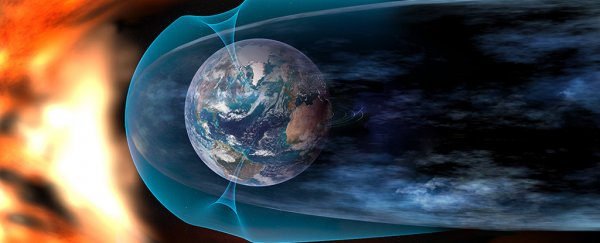Evidence of water in the shadows of craters or locked up in glassy beads like microscopic snow-globes has recently revealed the Moon's surface is far less desiccated than we ever imagined.
Just where this veneer of ice water came from is a mystery astronomers are currently trying to solve. One surprising possibility emerging is an elemental rain from our own atmosphere, delivered by Earth's magnetic field.
Water isn't exactly a rare substance in space. Given suitable places to hide, it can be sloshing around inside asteroids, coating comets, and even clinging precariously to the darkness of Mercury's craters.
It makes sense at least some of it will splash onto the Moon every now and then. But with the Sun's scorching heat and lacking protection from the vacuum of space, it's not expected to last very long.
To account for the surprising amount of moisture being found on the lunar surface, researchers have proposed a more dynamic form of production – a constant 'rain' of protons driven by the solar wind. These hydrogen ions smack into mineral oxides in the Moon's dust and rocks, ripping apart chemical bonds and forming a loose, temporary alliance with the oxygen.
It's a solid hypothesis, one that would be given a boost by observations of the more exposed (and more loosely bound) water molecules quickly succumbing to the vacuum of space whenever the Moon is sheltered from solar wind.
Our own planet happens to be pretty well protected from the constant breeze of ions blown from the Sun, thanks to a bubble of magnetism surrounding it. This force field not only surrounds us, it is blown into a tear-drop shape by the solar onslaught.
For a few days each month, the Moon passes through this magnetosphere, receiving a brief respite from the Sun's proton downpour.
An international team of researchers recently used plasma and magnetic field instruments on the Japanese Kaguya orbiter to pinpoint this precise timing in the Moon's orbit. Spectral data from Chandrayaan-1's Moon Mineralogy Mapper (M3) were then used to map the distribution of water across the Moon's surface at its highest latitudes.
The results weren't quite what anybody expected.
In short, nothing happened. The time-series of the Moon's watery signature revealed no appreciable difference in the three to five days spent hidden from the Sun's wind.
These results could mean a few things. One is that the whole solar wind hypothesis is a bust, and other reservoirs are responsible for replenishing the Moon's surface water.
But another intriguing possibility that doesn't require us to ditch the solar wind idea is that Earth's magnetic field simply picks up where the Sun leaves off.
Past research has suggested the sheet of plasma associated with our planet's magnetosphere could deliver about the same amount of hydrogen ions as the solar wind, especially towards the lunar poles.
It's not all delivered with quite the same amount of punch, admittedly, but the researchers hypothesise even the occasional heavy-hitting hydrogen ion could potentially create more than its fair share of water. And lower-energy protons might be more easily held in place, therefore less likely to fall apart in the moments after they're formed.
There's also every possibility that oxygen from the upper reaches of the atmosphere above our poles is carried across the vast stretch of emptiness to collide with the Moon, especially during periods of enhanced geomagnetic activity.
If this all sounds rather speculative, that's because it is. Right now, we only have a rather surprising map of water that doesn't quite align with favoured models.
But it points in some exciting new directions for the emerging field of Moon hydrodynamics. Since the researchers only mapped the water distribution at higher latitudes, it'll be worth looking closer to the equator for the predicted losses in the future.
On a practical front, we might need to rely heavily on a replenishing supply of lunar frost for fuel and life support one day, should the Moon become a stepping stone for space exploration.
If nothing else, we're slowly piecing together an understanding of a water cycle in space that helps us better understand the connections between our planet and its only natural satellite.
This research was published in the Astrophysical Journal Letters.
